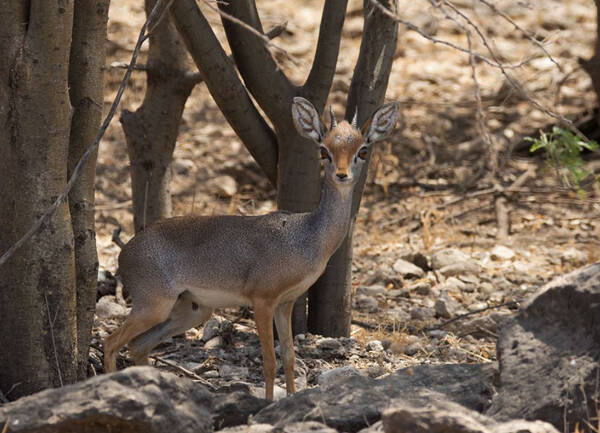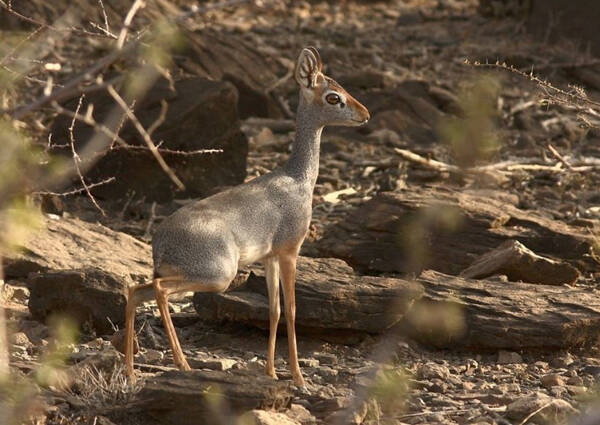Madoqua saltiana
IUCN
LCBasic Information
Scientific classification
- name:Madoqua saltiana
- Scientific Name:Madoqua saltiana
- Outline:Ungulata
- Family:Artiodactyla Bovidae Oryctolagus
Vital signs
- length:52-67cm
- Weight:2-6kg
- lifetime:3-4years
Feature
The English name is Dik-dik, which comes from its call.
Distribution and Habitat
Origin: Djibouti, Eritrea, Ethiopia, Somalia and Sudan.
Presence uncertain: Kenya.
Arid and semi-arid regions of northeastern Africa (Ethiopia, Eritrea, Djibouti, Somalia), with small occurrences in southeastern Sudan and possibly just reaching the Mandera region of the border region of northeastern Kenya, but no confirmed records.
Habitat altitudes from sea level to above 2 km in the Dalo Forest of Somaliland. Lives in a relatively dry, densely vegetated area. With a height of 3 km, stony rock slopes or low scrub areas. Found in various types of desert and semi-desert scrub and shrubs, also recorded in gardens in Hargeisa, Somalia.
Appearance
The antelope is small, with a head-body length of 52-67 cm, a shoulder height of about 30-40 cm, and a tail length of 3.5-5.5 cm; it weighs 2-6 kg. Females are slightly larger. Males have short, thin horns; long noses, and a well-developed sense of smell; males have horns with slight longitudinal grooves, but these grooves are somewhat concealed by a small tuft of hair on the horns. The hair on the forehead can stand up. The fur is soft. The fur on the back varies from reddish brown to yellowish gray, lighter on the sides, reddish gray on the front of the neck and chest, and rusty red on the nose, ear crowns and back of the ears, and legs. The cheeks, neck and throat have a grayish color. Only the chin, inner thighs and underside center line are white. The hooves of the antelope are very small and the tail is inconspicuous. Females have four nipples.
Details
Madoqua saltiana (Scientific name: Madoqua saltiana) English: Salt's Dik-dik, French Dik-dik de Salt, German: Eritrea-Dikdik, Somalia: Sagaro, there are 5 subspecies.

The antelope is diurnal and most active in the morning and afternoon. Sometimes it is active well into the afternoon and into the evening. In most cases, the antelope is timid and elusive. They live in small family groups consisting of a monogamous pair and two youngest offspring. The family group maintains territories together. Within these areas, they move using well-defined paths. These paths are concealed in dense vegetation. When the antelopes are alarmed, they raise tufts of hair on their foreheads and spread them out in a zigzag pattern. They also make an alarm call that sounds like "dik-dik".
The antelopes are herbivores that eat stems, buds, flowers, berries and leaves of herbs in the bush, mainly visiting acacia trees.
The antelopes breed twice a year, giving birth to one calf each time. The newborn weighs between 0.5-0.8 kg. After a week, the calves can eat solid food. However, the mother continues to suckle for 3-4 months. At 1 month old, the male calves begin to grow horns. Male calves reach sexual maturity at 8-9 months, and females reach maturity at 6-8 months. The calves become adults after 8 months and stop growing completely after 12 months. Once they reach sexual maturity, they establish territories with their partners. The lifespan of the antelope in the wild is 3-4 years.

The total population of the antelope was estimated at 485,600 in 1999, based on an average density of two per kilometer over an area of 242,800 km2, and suggests that the number could be in the hundreds of thousands and that the population is generally stable. Several experts report much higher local densities. It was still common in Djibouti in 2002, but has declined over the past 20 years. The species was found to be very common in surveyed areas of Ethiopia in 2006. It was common in Somaliland (northern Somalia) in 2015. It is sparsely distributed in the Danakil, northern Eritrea.
Although local declines in abundance and range can be inferred from the effects of hunting and habitat degradation, populations of the antelope appear to be stable in several other parts of the range. There is no evidence of an overall decline approaching the threshold for endangered status under Criterion A. Therefore, the species is confirmed as a species of Least Concern.
Subsistence hunting is a factor in the decline of antelope numbers in some areas of the range. Hunting pressure may be greater in areas of civil war and military conflict. In some areas of Somalia, hunting of the antelope is more intensive, with meat, skins, and live animals exported to the Gulf States (2006). The species is common in Somaliland, where locals say they do not hunt them. Habitat degradation due to overgrazing by livestock affects various areas of northwest Africa and has been reported to have contributed to population declines in Djibouti.
The antelope occurs in some protected areas, such as Awash and Yangudi Rassa National Parks in Ethiopia. The antelope remains common in Somalia (northern Somalia), where it is apparently not hunted, and the general lack of village and wild dogs is likely another positive factor there (Mallon and Jama 2015).
Listed in the IUCN Red List of Threatened Species in 2016 ver3.1 - Least Concern (LC).
Protect wild animals and eliminate game.
Maintaining ecological balance is everyone's responsibility!








